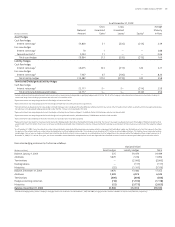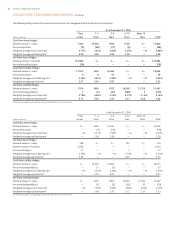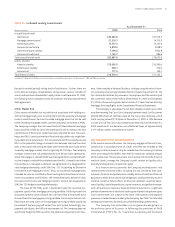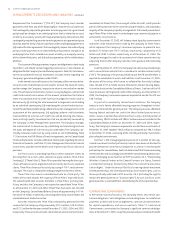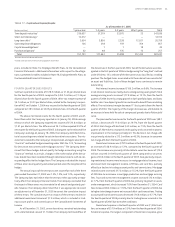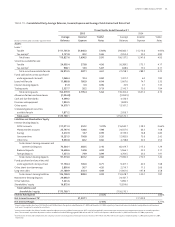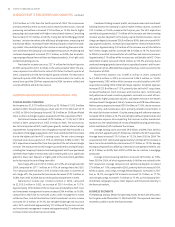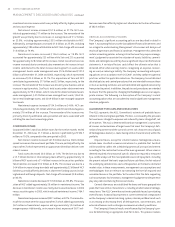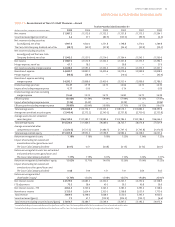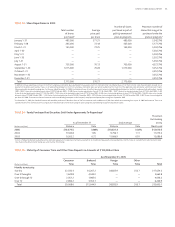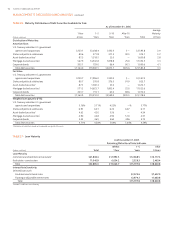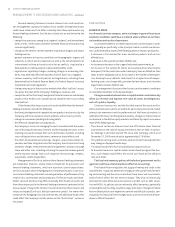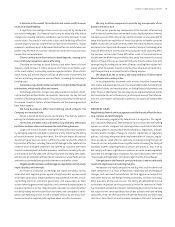SunTrust 2005 Annual Report Download - page 51
Download and view the complete annual report
Please find page 51 of the 2005 SunTrust annual report below. You can navigate through the pages in the report by either clicking on the pages listed below, or by using the keyword search tool below to find specific information within the annual report.SUNTRUST ANNUAL REPORT 49
management’s analysis of complex internal and external variables, and it
requires that management exercise judgment to estimate an appropriate
ALLL. As a result of the uncertainty associated with this subjectivity, the
Company cannot assure the precision of the amount reserved, should it
experience sizeable loan or lease losses in any particular period. For exam-
ple, changes in the financial condition of individual borrowers, economic
conditions, historical loss experience, or the condition of various markets
in which collateral may be sold could require the Company to significantly
decrease or increase the level of the ALLL and the associated provision for
loan losses. Such an adjustment could materially affect net income. For
additional discussion of the allowance for loan and lease losses see page
– Provision for Loan Losses and pages through – Allowance for Loan
and Lease Losses.
ESTIMATES OF FAIR VALUE
Fair value is defined as the amount at which a financial instrument could be
exchanged in a transaction between willing, unrelated parties in a normal
business transaction. The estimation of fair value is significant to a number
of SunTrust’s assets and liabilities, including loans held for sale, investment
securities, MSRs, OREO, other repossessed assets, goodwill, retirement and
post retirement benefit obligations, as well as assets and liabilities associ-
ated with derivative financial instruments. These are all recorded at either
fair value or at the lower of cost or fair value.
Fair value is based on quoted market prices for the same instrument
or for similar instruments adjusted for any differences in terms. If market
prices are not available, then fair value is estimated using modeling tech-
niques such as discounted cash flow analyses. In instances where required
by US GAAP, the Company uses discount rates in its determination of the fair
value of certain assets and liabilities such as retirement and post retirement
benefit obligations and MSRs. The Company provides disclosure of the key
economic assumptions used to measure MSRs and a sensitivity analysis to
adverse changes to these assumptions in Note , Securitization Activity/
Mortgage Servicing Rights, to the Consolidated Financial Statements. The
fair values of MSRs are based on discounted cash flow analyses utilizing
dealer consensus prepayment speeds and market discount rates. A detailed
discussion of key variables, including discount rate, used in the determi-
nation of retirement and post retirement obligations is in the Pension
Accounting section. Discount rates used are those considered to be com-
mensurate with the risks involved. A change in these discount rates could
increase or decrease the values of those assets and liabilities.
Fair values for investment securities and most derivative financial
instruments are based on quoted market prices. If quoted market prices are
not available, fair values are based on the quoted prices of similar instru-
ments. The fair values of loans held for sale are based on observable cur-
rent market prices. The fair values of OREO and other repossessed assets
are typically determined based on appraisals by third parties, less estimated
selling costs.
Estimates of fair value are also required in performing an impairment
analysis of goodwill. The Company reviews goodwill for impairment at the
reporting unit level on an annual basis, or more often if events or circum-
stances indicate the carrying value may not be recoverable. The goodwill
impairment test compares the fair value of the reporting unit with its car-
rying value, including goodwill. If the carrying amount of the reporting unit
exceeds its fair value an additional analysis must be performed to determine
the amount, if any, by which goodwill is impaired. In determining the fair
value of SunTrust’s reporting units, management uses discounted cash flow
models which require assumptions about the Company’s revenue growth
rate and the cost of equity.
PENSION ACCOUNTING
Several variables affect the annual pension cost and the annual variability
of cost for the SunTrust retirement programs. The main variables are: ()
size and characteristics of the employee population, () discount rate, ()
expected long-term rate of return on plan assets, () recognition of actual
asset returns and () other actuarial assumptions. Below is a brief descrip-
tion of these variables and the effect they have on SunTrust’s pension costs.
Size And Characteristics Of The Employee Population
Pension cost is directly related to the number of employees covered by the
plans, and other factors including salary, age, and years of employment. The
number of employees eligible for pension benefits has increased over prior
years, especially with the addition of NCF employees at the end of .
Discount Rate
The discount rate is used to determine the present value of future benefit
obligations. The discount rate for each plan is determined by matching the
expected cash flows of each plan to a yield curve based on long term, high
quality fixed income debt instruments available as of the measurement
date, December . This assumption is updated every year for each plan.
The discount rate for each plan is reset annually on the measurement date
to reflect current market conditions for high quality bonds.
If the Company were to assume a .% increase/ decrease in the dis-
count rate for all retirement and other post retirement plans, and keep all
other assumptions constant, the benefit cost would decrease/ increase by
approximately million.
Expected Long-term Rate Of Return On Plan Assets
Based on a ten-year capital market projection of the target asset alloca-
tion set forth in the investment policy for the SunTrust and NCF Retirement
Plans, the pre-tax expected rate of return on plan assets was .% in
and . This expected rate of return is not expected to change signifi-
cantly each year.
Annual differences, if any, between expected and actual returns
are included in the unrecognized net actuarial gain or loss amount. The
Company generally amortizes any unrecognized net actuarial gain or loss in
excess of a % corridor, as defined in SFAS No. , “Employers’ Accounting
for Pensions,” (“SFAS No. ”) in net periodic pension expense over the
average future service of active employees, which is approximately eight
years. See Note , Employee Benefit Plans, to the Consolidated Financial
Statements for details on changes in the pension benefit obligation and the
fair value of plan assets.
If the Company were to assume a .% increase/decrease in the
expected long-term rate of return for the retirement and other post retire-
ment plans, holding all other actuarial assumptions constant, the benefit
cost would decrease/increase by approximately million.
Recognition Of Actual Asset Returns
SFAS No. allows for the use of an asset value that smooths investment
gains and losses over a period up to five years. However, SunTrust has
elected to use a more preferable method in determining pension expense.
This method uses the actual market value of the plan assets, and therefore,
immediately recognizes prior gains and losses. Therefore, SunTrust will


